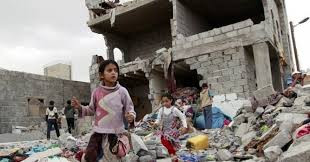
SANAA, Feb. 22(Saba) -The war in Yemen has turned the country into the world’s largest humanitarian crisis.
Yemen is now home to the largest food insecure population in the world.
Millions more Yemenis are suffering from the mental trauma and stress of living through years of war with wide ranging impacts on physical health, education, increased risks of domestic violence, and their ability to work.
Owing to the war which is being played out on Yemeni soil, civilian institutions and ports are being intentionally bombed by Saudi air forces, the bombing of sites such as ports halts the distribution of staple food products which is crucial as ca.
Analysis suggests that if war were to persist, disrupting port operations or cutting off food supply for a prolonged period of time, there is a likelihood that famine conditions would return.iv IRC’s analysis shows that levels of child hunger (as represented by levels of Severe Acute Malnutrition – SAM) have declined at a rate of 8 percent between 2017 and 2019.
Yet by merely maintaining this rate of decline it will take 20 years to return Yemen to pre-crisis levels of child hunger; levels already amongst the highest in the world.v IRC analysis further shows that if the war continues for another five years it will cost the international community as much as $29 billion in humanitarian funding.
Yemen holds the unenviable title of the world’s largest humanitarian emergency : over 14 million people are now in acute need of humanitarian assistance, nearly half of the country’s population.
5 years of war that has destroyed Yemen’s infrastructure, derailed its already-fragile economy and upended its agricultural capacity.
An important blow to the provision of humanitarian aid in Yemen was the strategic bombing of Sanaa Airport in the Yemeni capital in November of 2017 which severely limited the amount of medical aid coming through to the country, this was a particularly malicious blow seeing as flights were already limited to UN aid flights by the Saudis in August 2016. Owing to these planned attacks many are left in urgent need of aid, left without a home, malnourished or dangerously ill.
The damaged water infrastructure in Yemen coupled with the water scarcity in the country, sky-high water prices and the urgent need of sanitation assistance in many permanent and temporary homes laid a very favorable environment for cholera to thrive and ravage the nation’s citizens.
The internal displacement of people is yet another main shaper of why the situation in Yemen can be deemed a humanitarian crisis. With 2,014,026 people displaced as of March 2018, shelter is in urgent demand as a direct result of the destruction of civilian homes in the recently intensified fighting.
“in Yemen, children can no longer safely do the things that all children love to do, like go to school or spend time with their friends outside. The war can reach them wherever they are, even in their own homes.”
This war that Yemeni children have had to face will not only scar them psychologically for the majority of their lives but the damage to cognitive development caused will most likely induce learning difficulties and will thus put them at a disadvantage in the workplace in the future trapping them and their family in a cycle of poverty.
Millions of people are starving, sick and desperate. They have one message for the world: this war needs to stop.
In conclusion, the issues underlined throughout the articles ultimately have one solution – end the war and restore peace and trade in the country in order to help affected Yemenis, who are without a doubt the majority of the population of Yemen.
M.M